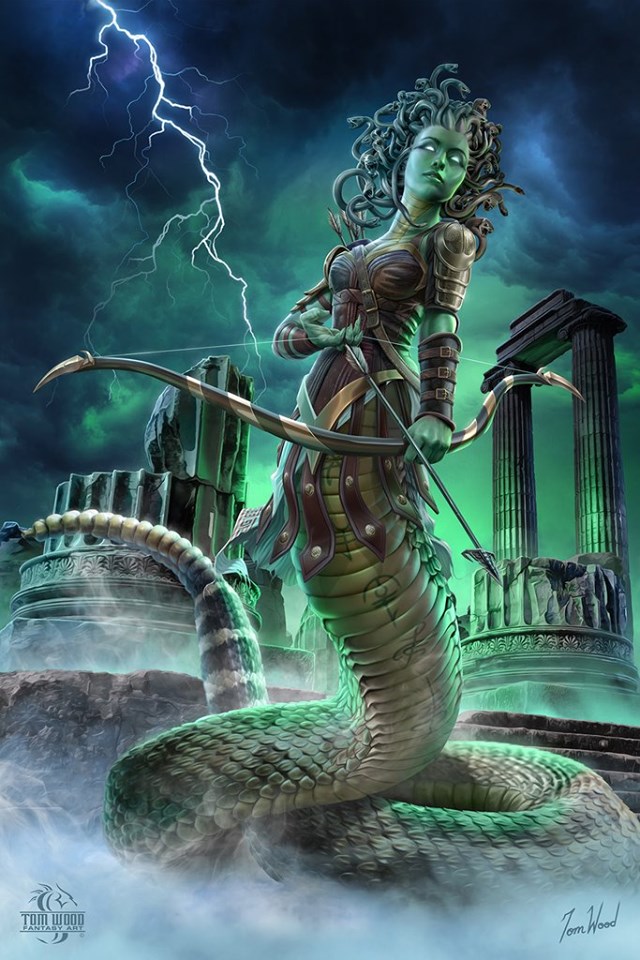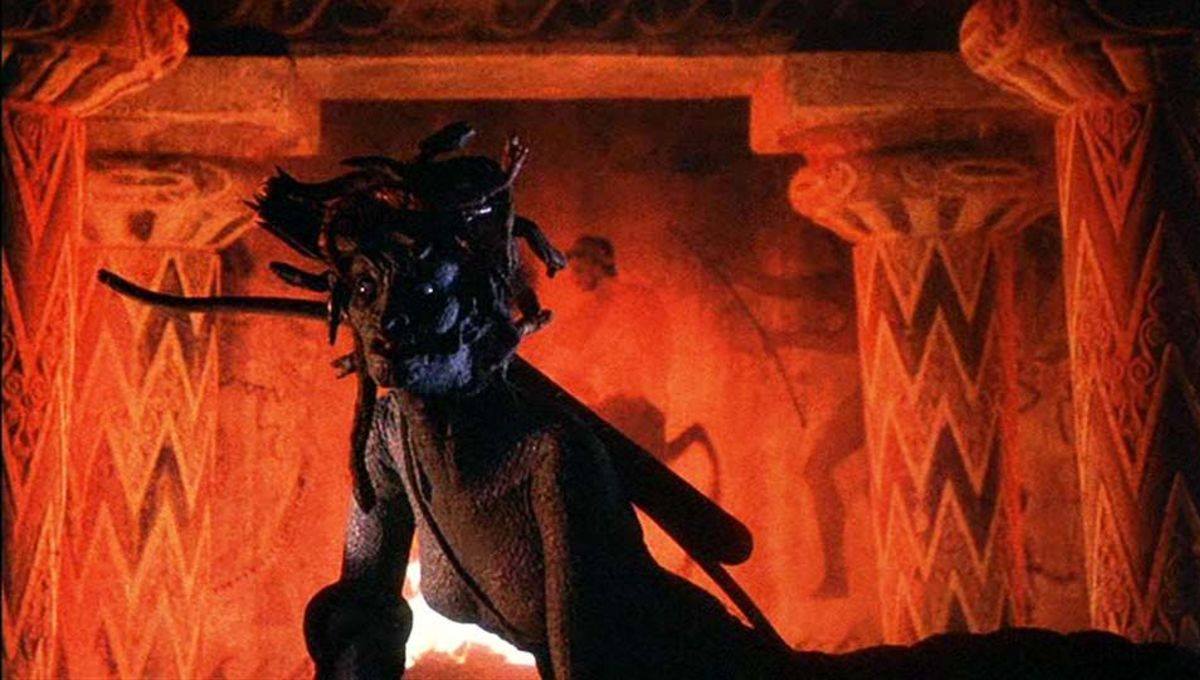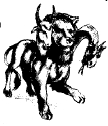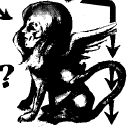

Some say Medusa had wings
of gold,
tusks like a swine, and snakes for hair,
and her clawed hands were made of
brass. Older sources state she had the
body of a mare; still others praise her
as
fair-cheeked and beautiful (in a tragic
style). All legends and sources agree
that to view her face was to be turned
to
stone.

The greek hero Perseus
decapitated
Medusa, aiming his blow by looking at
her reflection in the brass shield lent
him
by the goddess Athena.
Medusa’s petrifying
face, the Gorgoneion, retained its
potency — it was used by Perseus, then
given to Athena. From Medusa’s severed
neck spouted her life blood and two living
beings, both fathered by Poseidon:
Pegasus and Chrysaor.
WHO’S WHO IN MEDUSA’S FAMILY: Medusa
(1), who was beheaded
by Perseus, produced Pegasus (2) and
Chrysaor (3). Chrysaor wed
Callirhoe (4), producing Geryon (5)
and Echidna (6). Geryon,
according to Spenser, bred Geryoneo
(7), whose mother is unknown.
The offspring of Echidna and Typhon
(8), were several foul monsters:
Orthus (9), Cerberus (10), the Lernaean
Hydra (11), and the Monster
of Geryoneo (12). Echidna and Orthus
produced the Theban Sphinx
(13) and Nemean Lion (14). The Hydra,
whose mate is unknown, bore
the Chimaera (15). Finally, the parentage
of the Blatant Beast (16) is
disputed, being either the offspring
of Cerberus and the Chimaera, or
of Echidna and Typhon.
The fabled winged
horse is described
in the AD&D™ Monster Manual,
albeit
rationalized to fit a more general mythos/
cosmos. Pallas Athena gave the
Greek hero Bellerophon a golden bridle
so that he might tame and ride Pegasus.
Thus able to work together, the two
killed the evil Chimaera, the grand-niece
of Pegasus.
After helping in several other virtuous
acts, the immortal steed threw his master
(who had become impiously proud) and
flew to the heavens, to carry the thunderbolts
of Zeus and to become
the constellation
of Pegasus.
His name means “he
of the golden
sword,” and
Chrysaor Phorcides is lauded
as a hero; yet any valiant — or dastardly
— deeds of his are unrecorded.
Ironically, Bellerophon as a child was
called Chrysaor — but he soon changed
his name to “Bellerus-killer,” a less anonymous
appellation. Chrysaor’s only important
act was to wed the Oceanid Callirhoe
and produce two of the foulest
offspring ever born: Geryon and Echidna.
FREQUENCY: Unique
NO. APPEARING: 1
ARMOR CLASS: 4
MOVE: 12”/18”
HIT DICE: 100 hit points per body
% IN LAIR: Nil
TREASURE TYPE: Nil
NO. OF ATTACKS: 3
DAMAGE/ATTACK: 2-16/2-16/2-16
SPECIAL ATTACKS: Hurl rocks for 2-16
points damage each, up to 20” range
SPECIAL DEFENSES: See below
MAGIC RESISTANCE: 15%
INTELLIGENCE: Low
ALIGNMENT: Neutral evil
SIZE: L (10’ tall)
PSIONIC ABILITY: Nil
Attack/Defense Modes: Nil
Geryon is a 3-headed, 3-bodied
giant -- not to be confused with the
Archdevil
of the same name (and the
same basic temperament). The 10th labor
of Hercules was to capture the cattle
of Geryon. He journeyed to Geryon's
homeland, the island of Erythia, "the
red" (called such because it is in the
far
west, past the straits of Gilbraltar, thus
lit
with the ruby rays of the setting sun).
In
performing his task, Hercules incidentally
killed Geryon, his guard-dog Orthus,
and his herdsman Eurytion.
Geryon's 3 bodies are joined at the
waist, and each body is complete -- although
he is also sometimes represented
as having just 2 legs, which would
make him appear even more inhuman.
Measure lost HP on each body
separately; when a body goes below
zero hit points, it becomes a dead weight
and may no longer attack. Geryon is not
killed until all three bodies are dead.
Each of the three bodies may be entitled
to save against spells, etc. individually,
but Geryon has only one mind.
Geryon attacks and defends as a monster
of 12 HD. With his excellent vision
(tri-binocular?) and hearing, he is
only surprised on a 1.
Geryon is red-skinned with blood-rust
hair and large, deep eyes of fiery garnet.
He has six scarlet wings (a pair for each
torso), and is clad in carmine cowhide.
Edmund Spenser, in his allegory The
Faerie Queene, has a wingless Geryon
represent Charles V of Spain, and invents
for him an identical son, Geryoneo,
portraying Philip II of Spain (and
the Spanish domination of the Netherlands).
As he would be used in an AD&D™
adventure, Geryoneo is like his father
except for movement rate (12”), percent
in lair (40%) and treasure type (B, C,
E).
Geryoneo’s lair is in the castle which
formerly defended the city of the widowed
Lady Belge. This fortress is heavily
garrisoned; its seneschal, the Prince
of Parma, is a 10th-level Lord (AC 2; +2
long sword; potion of extra-healing; potion
of longevity).
As one expression of his disposition
and nature, Geryoneo erected an idol in
the likeness of his father in a chapel
outside
the city and forced the city’s inhabitants
to worship it. To know more of the
monster guarding the fane of Geryon,
we must first learn of the other — even
mightier and more malign — branch of
the union of Chrysaor and Callirhoe:
Echidna and her spawn.
FREQUENCY: Unique
NO. APPEARING: 1
ARMOR CLASS: 7 (human body) or
0 (dragon body)
MOVE: 12”/18”
HIT DICE: 90 hit points
% IN LAIR: 95%
TREASURE TYPE: I, X
NO. OF ATTACKS: 2 or 1
DAMAGE/ATTACK: 4-16/4-16 or by
weapon
SPECIAL ATTACKS: See below
SPECIAL DEFENSES: See below
MAGIC RESISTANCE: 75%
INTELLIGENCE: High
ALIGNMENT: Neutral evil
SIZE: L (40' long)
PSIONIC ABILITIY: 150
Attack/Defense Modes: C, D / F, G, H
Echidna is an immortal half-woman,
half-dragon who may be encountered
hunting far below ground or in the wilderness
on dark nights. For the most part
she dwells in her lair on the darkest plane
of Hades.
“Echidna is a Monster direfull dred,
Whom Gods doe hate, and heavens
abhor to see;
So hideous is her shape, so huge her
hed,
That even the hellish fiends
affrighted bee
At sight thereof, and from her
presence flee:
Yet did her face and former parts
professe
A faire young Mayden, full of comely
glee;
But all her hinder parts did plaine
expresse
A monstrous Dragon, full of fearful
uglinesse.”
(The Faerie Queene, book VI, canto
VI,
verse 10)
"... grisly Echnida,
a nymph who never dies, and all her
days is ageless."
(Hesiod, Theogony, 304-5)
Anyone beholding Echidna must save
(as if vs. a spell cast by a magic-user
of
20th level) or else flee in panic. She
has
infravision and is unaffected by charms
of any sort.
Echidna can employ any of these three
powers, one at a time, as often as desired:
Darkness, Silence 15’ Radius, and
Plane Shift. Once per day she may cast
the following spells: Continual Darkness,
Lose the Path, Symbol (Hopelessness)
and Symbol (Insanity, specifically melancholia).
All of her magical abilities are
performed as a 20th-level spell caster.
The monster customarily fights with
her two claws, but if forced to hunt in
the
open she prefers a medium lance and
large shield (improving the armor class
of her human head and upper body
accordingly).
Echidna is solitary and resents any intrusions.
She is described by Hesiod as:
“... the divine and haughty Echidna,
and half of her is a nymph with a
fair face and eyes glancing, but the
other half is a monstrous snake, terrible,
enormous and squirming and
voracious, there in earth’s secret
places. For there she has her cave on
the underside of a hollow rock, far
from the immortal gods, and far from
all mortals.”
(Theogony, 297-302)
Echidna bred several monsters by Typhon
(not the fratricidal Egyptian
god of
evil,
but a like-minded chaotic monsterdeity,
thrown by Zeus
into the underworld
and trapped there forever). Typhon
was a humanoid, tall as a mountain,
of earthshaking proportions and
strength; from his shoulders sprang 100
serpent heads which spake the speech
of gods, bellowed, barked, roared and
whistled in the name of “Typhaon, the
terrible, violent and lawless.”
“First she bore him Orthus, who
was Geryones’ herding dog, ...”
(Theogony, 309)
This is the two-headed dog of Geryon,
killed by Hercules. To portray Orthus in
AD&D terms, use the Monster
Manual
description of the war
dog, with these
differences:
FREQUENCY: Unique
NO. APPEARING: 1
ARMOR CLASS: 4
HIT DICE: 7
NO. OF ATTACKS: 2
DAMAGE/ATTACK: 2-12/2-12
SIZE: L
“... and next again she bore the
unspeakable, unmanageable
Kerberos, the savage, the bronzebarking
dog of Hades,
fifty-headed, and powerful, and
without pity.”
(Theogony, 310-2)
The number of Cerberus’ heads is variously
3, 5, or 50, according to different
sources; see the DDG for details
of the beast as a
3-headed (most easily playable) monster.
It was Hercules’
twelfth labor to
drag Cerberus up from the Underworld.
“And third again she bore the
grisly-minded Hydra
of Lerna, whom the goddess
white-armed Hera
nourished
because of her quenchless grudge
against the strong Herakles.”
(Theogony, 313-5)
Hercules killed the Lernaean Hydra,
with the help of his squire Iolaus, as
his
second task. The monster is a watersnake
rather than a legged reptile, but
otherwise the creature conforms with
the Lernaean
Hydra as described in the
Monster Manual.
THE CHIMAERA
“Hydra bore the Chimaira, who
snorted raging fire,
a beast great and terrible,
and strong and swift-footed.
Her heads were three: one was
that of a glare-eyed lion,
one of a goat, and the third
of a snake,
a powerful dragon.”
(Theogony, 319-24)

This creature is essentially the same
as the chimera
described in the Monster
Manual, except that its movement
rate is
18”; that is, the beast has no wings but
can run as fast as a wolf.
King Iobates of Lycia, with his realm
being plagued by the Chimaera, commissioned
the hero Bellerophon to slay
her. Bellerophon succeeded, much to
Iobates’ delight — and survived, much to
his chagrin. The monarch had wanted
Bellerophon discreetly dead as a political
favor to his majesty’s son-in-law,
King Proetus of Tiryns. The inconvenience
of Bellerophon’s
survival was solely
the result of Pegasus, instead of a mortal
mount, having borne him into the
battle.
THE THEBAN
SPHINX
“But Echidna also, in love with
Orthus, mothered the deadly
Sphinx, the bane of the Kadmeians,
and the Nemeian Lion”
(Theogony, 326-7)
The Theban Sphinx conforms closely
to the Monster Manual listing for
the Gynosphinx.
She dwelt near Thebes and
spent her time harassing passing natives,
baffling them with her riddle, and
then — while they were still in a confused
state — pouncing upon and devouring
them.
She was enraged when Oedipus gave
her the answer to her riddle. Rather than
admit defeat, the Sphinx killed herself
in
fury.
THE NEMEIAN
LION
‘“... the Nemeian Lion
whom Hera, the queenly wife of
Zeus, trained up and settled
among the hills of Nemeia, to be
a plague to mankind.
There he preyed upon the tribes
of the indwelling people,
and was as a King over Tretos
and Apesas and Nemeia.
Nevertheless, the force of strong
Herakles subdued him.”
(Theogony, 327-32)
The first labor of Hercules was to slay
the Nemeian Lion. Use the characteristics
for the spotted
lion given in the
Monster Manual, except for:
FREQUENCY: Unique
NO. APPEARING: 1
ARMOR CLASS: Special
(see below)
HIT DICE: 50 hit points
SPECIAL DEFENSES: See
below
The Nemeian Lion is invulnerable to
weapons except for its own claws; by
physical attack, the lion may only be suffocated
or drowned. It is vulnerable to
any appropriate detection spells. The
beast should be allowed a saving throw
vs. Holy/Unholy Word or Time Stop
spells; all other non-asphyxiating spells
are totally futile. The animal is surprised
only on a 1. The Lion has no psionics,
nor can it be harmed psionically. Upon
his death, the lion became the constellation
Leo.

This man-eating devil, the creation of
Edmund Spenser, represents the Spanish
Inquisition. She lives under the shrine
to Geryon, defending the heathen idol
and devouring sacrificial victims. Until
the noble paladin Prince
Arthur defeated
her, no stranger had seen the monster
and survived.
“An huge great Beast it was, when it
in length
Was stretched forth, that nigh fild
all the place,
And seem’d to be of infinite
great strength:
Horrible, hideous, and of hellish race,
Borne of the brooding of Echidna
base,
Or other like infernal furies kind;
For of a Mayd she had the outward
face,
To hide the horrour which did
lurke behinde,
The better to beguile whom she so
fond did finde.
Thereto the body of a dog she had
Full of fell ravin and fierce
greedinesse;
A lions claws, with powre and rigour
clad,
To rend and teare what so she
can oppresse;
A Dragons taile, whose sting
without redresse
Full deadly wounds where so it
is empight;
And Eagles wings, for scope and
speedinesse,
That nothing may escape her
reaching might,
Whereto she ever list to make her
hardy flight.”
(The Faerie Queene, V, Xl, 23-4)
FREQUENCY: Unique
NO. APPEARING: 1
ARMOR CLASS: 5 (body)/2 (tail)
MOVE: 6”/48”
HIT DICE: 120 hit points
% IN LAIR: 100%
TREASURE TYPE: See below
NO. OF ATTACKS: 2 claws, 1 tail
DAMAGE/ATTACK: 1-6/1-6/1-10 or
1-6/1-6/1-6
SPECIAL ATTACKS: See below
SPECIAL DEFENSES: See below
MAGIC RESISTANCE: 30%
INTELLIGENCE: Average
ALIGNMENT: Lawful evil
SIZE: L (body 8’, tail 22’)
PSIONIC ABILITY: Nil
Attack/Defense Modes: Nil; immune
to psionic attack
The Monster of Geryoneo has a woman’s
face; the body of a giant dog; feathered
wings of a Giant Eagle; leonine
claws; and a long, heavy, draconian tail,
with a stinger (not poisoned, but strikes
at +2).
The monster fights and saves as a
creature of 12 hit dice. Her tail will
either
be used as a thrusting weapon for 1-10
points of damage or as a cudgel for 1-6
points (50% chance of each). A successful
hit by the tail in either attack mode
may have a secondary effect, determined
by rolling d8: 1 = opponent stunned for
1-12 rounds; 2 = opponent knocked
prone for 1-8 rounds; 3-8 = no effect.
(DM’s discretion: Alter the dice rolls
accordingly
if the monster’s victim is clad
in anything less sturdy than splint mail
and shield, AC 3).
If both claws sink into the same target,
the creature will either rend her victim
for 1-8 points of additional damage, or
(25% chance) automatically disarm the
adversary.
When a character is fighting with a
magic sword of at least moderate power
(DM’s evaluation, with +2 as a suggested
norm) and slashing at the body, a natural
roll of 20 “to hit” has killed the fiend
by
disemboweling her. However, in such an
instance, the vapors which will spurt out
of her remains are poisonous: Every
character closer than 30 feet to her at
the
time of her death, or any character who
comes that close within a span of 10
rounds thereafter, must save vs. poison
or die.
The vapors are considered to have
dispersed after 10 rounds, assuming
calm air and a sufficiently large volume
for the gases to dissipate into — either
the great outdoors or a vast underground
cavern (such as the temple area is presumed
to be). The DM should modify the
duration of the poison’s effect depending
on varying circumstances. A relatively
small chamber with small openings
would serve to contain the poisonous
cloud for more than 10 rounds, possibly
for a number of hours. But if the creature
is killed in this fashion while outdoors,
even the slightest of natural air currents
would carry the vapors away in less time.
The Monster of Geryoneo is only encountered
within the temple she guards,
or in the grounds near the shrine. The
idol of Geryon which she watches over is
made of solid gold and mounted on a
massive altar of ivory.
This creature is a great dog with iron
teeth and a hundred tongues, typifying
slander. The Blatant Beast is the true
scion of the gorgons and unmistakable
issue of Typhon; however, as befits the
epitome of deceit, his exact lineage is
disputed. He is either the son of Cerberus
and the Chimaera, or of Echidna and
Typhon.
This scurrilous cur delights in despoiling
monasteries and churches, ravaging
maidens, causing chaos and pandemonium,
spreading vile but unfounded
rumors, and other simple pleasures of
the evil life.
FREQUENCY: Unique
NO. APPEARING: 1
ARMOR CLASS: 5
MOVE: 12”
HIT DICE: 50 hit points (11 hit dice)
% IN LAIR: Nil
TREASURE TYPE: Nil
NO. OF ATTACKS: 1
DAMAGE/ATTACK: 2-12
SPECIAL ATTACKS: Slander, festering
wounds
SPECIAL DEFENSES: Only harmed by
iron weapons; regeneration
MAGIC RESISTANCE: Invulnerable to
all magic
INTELLIGENCE: Extremely cunning,
but very unwise
ALIGNMENT: Chaotic evil
SIZE: L
PSIONIC ABILITY: Nil
Attack/Defense Modes: Nil; immune
to psionic attack
The Blatant Beast can make himself
understood to all creatures capable of
speech, simultaneously, and will harass
and slander anybody regardless of alignment
or station. Anyone or anything
within hearing and less than 4th level
or 4
hit dice must save vs. poison; failure
indicates
that the listener believes the
beast’s lies with fanatical conviction,
and
must act accordingly. Those not abused
by the beast’s slanders and lies, and
those who appear not to believe the
fiend’s claims about others, will be savaged
by its physical attack.
“(he) ... spake licentious words and
hatefull things
Of good and bad alike, of low
and hie,
Ne Kesars spared he a whit,
nor Kings;
But either blotted them with infamie,
Or bit them with his baneful teeth
of injury.”
(The Faerie Queene, VI, XII, 28, 5-9)
Wounds caused by the beast’s rusty
iron teeth will not heal normally but will
become infected and fester, causing the
loss of 1-3 hit points per day for each
wound so suffered. Magical cures will
restore lost hit points to a victim as
usual,
but will not prevent further festering
and
infection on subsequent days. The only
way to permanently cure these injuries
is
to:
“Abstaine from pleasure, and
restraine your will;
Subdue desire, and bridle loose
delight;
Use scanted diet, and forbeare
your fill;”
(The Faerie Queene, VI, VI, 14,
5-7)
In AD&D terms, this requires
a greater
degree of inactivity than described under
“Recovery
of Hit Points” on p. 82 of the
DMG. The victim cannot
engage in combat, spell casting, or
any other strenuous activity. Beyond
that, the victim must voluntarily quarantine
and restrict him or herself: No activity
which brings pleasure to oneself is
allowed, and only a minimum amount of
necessary nourishment should be taken.
Total bedrest and abstinence is neces-
sary, for a period of time long enough
to
restore any hit points lost (and not yet
cured magically) from either the original
wound(s) or the festering and infection.
After that number of hit points is regained,
further rest and recuperation
under the less stringent requirements of
the DMG will restore other hit points
as
usual.
The Blatant Beast will flee from any
honest or courteous Paladin questing after
him, especially if the hero is of obvious
nobility, unless cornered.
The monster may only be affected or
conquered with implements and weapons
of iron. It regenerates damage
done by iron weapons or implements at
the rate of 5 points per round, as its
father/
brother Cerberus
does.
BIBLIOGRAPHY
Spenser, The Faerie Queene,
in 2 vols.,
J. M. Dent & Sons, London, 1910
Hesiod, Theogony, trans.
Lattimore,
University of Michigan, 1959
Kerenyi, The Gods of the Greeks,
trans. Cameron, Thames & Hudson,
London, 1951
Kerenyi, The Heroes of the Greeks,
trans. Rose, Thames & Hudson, London
1959
Bullfinch, Mythology, Avenel
Books,
New York, 1978 printing
| Dragon magazine | - | Monster Manual III | - | Dragon #58 |